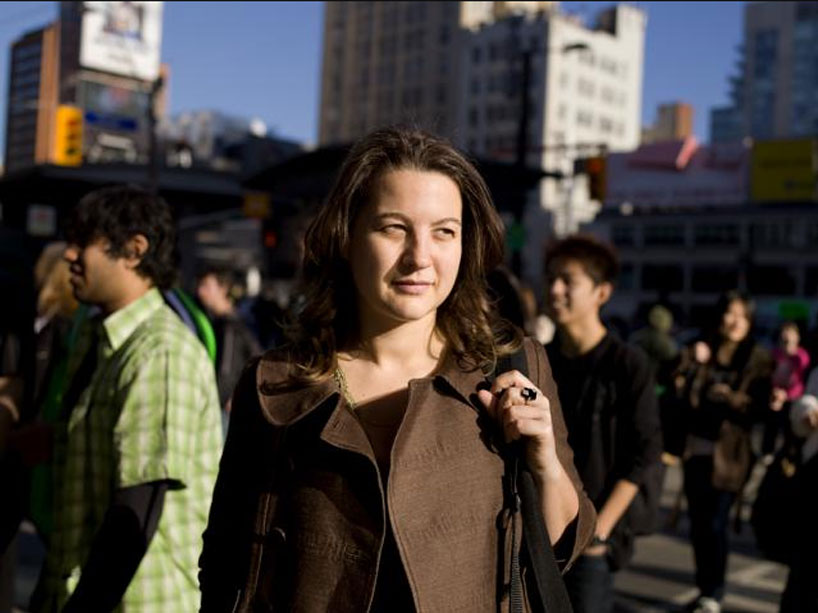Photography curator honoured by French government

Gaëlle Morel is the Ryerson Image Centre’s exhibitions curator. She was granted the title of Knight of the Order of Arts and Letters by the French government in November. Photo by Jordan Roberts.
“I like photography as a medium in the middle,” says Gaëlle Morel, exhibitions curator at the Ryerson Image Centre (external link) (RIC). “You can have a photograph published in the newspaper, and then the next day it can be on the wall of a museum. I like the change in the status of the object.”
As a curator and scholar, Morel is fascinated by how photography evades categorization: how documentary images can influence fine art; how fine art can influence photojournalism; and how photography mediates our reality. As a curator, she routinely finds the aesthetic qualities in objects that have been considered strictly functional.
“Press photographs can become cultural objects, and sometimes even artistic objects, only considered for their aesthetics—but they were not created as artistic objects,” says Morel. “I kind of like the lack of boundaries—the fact that it can navigate from one field to another.”
In November, Morel was granted the rank of Chevalier de l’Ordre des Arts et des Lettres (Knight of the Order of Arts and Letters) by the French government. One of the country’s most prestigious honours, the designation was announced by France’s just-departed Minister of Culture, Françoise Nyssen. “What’s great about the award, besides the personal aspect, is that it’s recognition of work in the cultural and artistic field,” says Morel. “I appreciate that it’s an award for work as an ambassador for culture in general, not just French culture.”
“Her background had a unique combination of academic talent and knowledge,” says Doina Popescu, former director of the RIC, who hired Morel. “The Ryerson Image Centre has a collection of documentary and fine-art photography, and is dedicated to both the still image and the moving image in dialogue. Gaëlle had strengths in all the areas that we wanted to represent—and she could bridge the areas.”
Born in France and educated at Université Paris 1-Panthéon-Sorbonne (where she received her PhD), and has taught photography history in both France and Canada. As a researcher, her focus has been photography from the 1970s and 1930s. Why these two eras? “In the ’30s in the United States, photography was more and more included in museums,” says Morel. “Curators were hired where there were none before. This idea of a photo curator was kind-of new. It started with MoMA in New York in the late ’20s, and some photo dealers tried to sell prints to collectors, and it was very hard—not that successful. This moment in time where you had this change happening, I’m very interested in.”
A similar shift in perceptions happened in the 1970s. “It was really the second phase of that recognition, where institutions reinforced this idea of the medium as an important cultural object that should be looked at, valued, preserved, collected, exhibited, written about.”
Morel made her mark in Canada in 2009 when she guest-curated the Mois de la Photo in Montreal. That biennial, titled The Spaces of the Image, brought together artists from 13 countries to explore what it means to stage and present contemporary photography as an installation form. In 2011, she was announced as the RIC’s first exhibitions curator, shortly before the centre’s opening in 2012.
At the RIC, Morel develops and implements the exhibition programs, selects and collaborates with photographers and guest curators, and builds institutional partnerships nationally and internationally. “In all three roles, she brings a strong creative sensibility, fierce ethics and sense of responsibility, and a spirit of risk-taking,” says Paul Roth, director of the RIC. “Gaëlle is one of the most talented installation curators I have ever known: she never makes the easy decision about how to juxtapose artworks, but would rather experiment to find a more revelatory presentation of the photographs we exhibit.”
Popescu highlights one of the first RIC exhibitions that Morel curated: a comprehensive retrospective of Berenice Abbott, the photographer who chronicled New York City’s people and places between the World Wars. The exhibition was mounted in association with Paris’s Jeu de Paume, and led to the RIC’s major acquisition of the Berenice Abbott Archive (external link) . “She brought her expertise in Berenice Abbott, but she also helped catapult us into another area for us, which was international collaboration,” says Popescu.
Other major exhibitions Morel has curated include 2015’s Burn With Desire: Photography and Glamour (external link) , an ambitious and critical collection of media representations of female glamour since the 1920s; and 2014’s Robert Burley: The Disappearance of Darkness, which showcased Burley’s photographs of shuttered film-manufacturing facilities across North America and Europe. “His project speaks to the Ryerson Image Centre’s identity,” says Morel of the Burley exhibition. “What happened to photography with this digital turn? What are the implications and consequences of this major shift? He looked at it through a very interesting perspective, which was the disappearance of those big plants and factories that were so crucial for Toronto or Rochester.”
This broad, historically-minded view of photography is key to her curatorial skill. Paul Roth says, “Gaëlle is at that key moment in her career when she has a reservoir of great experience behind her, but still retains the energy, passion and spirit of invention characteristic of a rising star in our field. I think the honour she’s received is perfectly timed, celebrating what she has already achieved while also giving notice—and an imprimatur of approval—for the great things yet to come.”